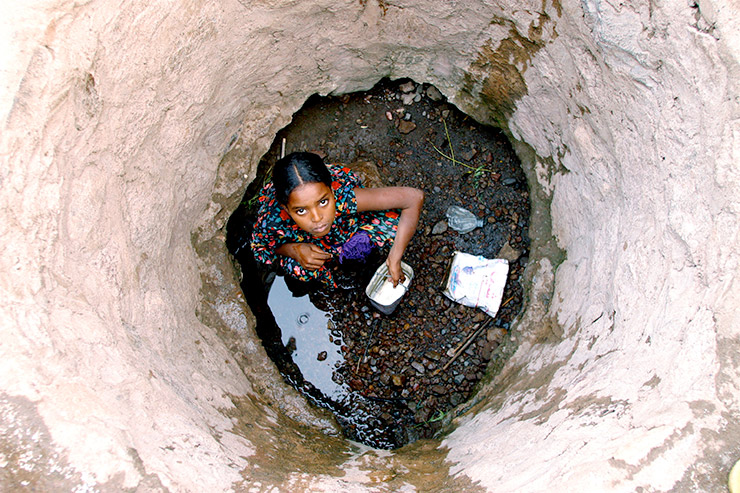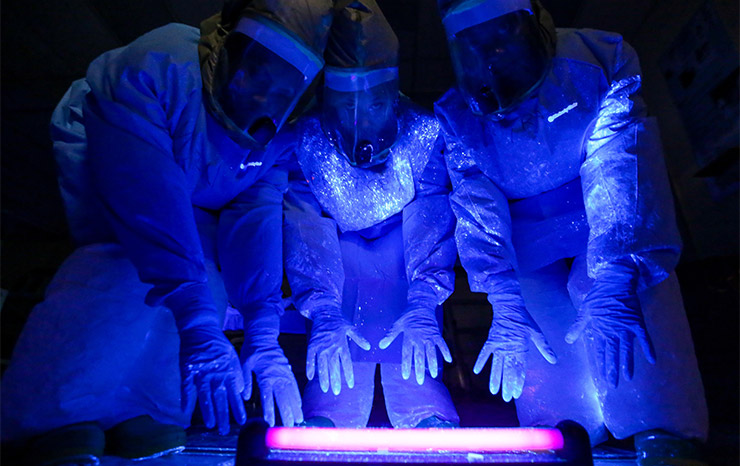CRJ Issue 10:2, Winter 2014
The winter edition of the CRJ has now gone to press. This is what's inside...
News: New Editorial Advisory Panel Member, Paola Albrito, Head of the UN office for Disaster Risk Reduction, Europe; UK/US Cybersecurity initiative; Catastrophic mass mortality event would not effect population growth; Public alert systems; Evacuations app wins UN Global Disaster Resilience Challenge; Global terror trends; Complex terrorist attack drill in Belgium; Ensuring food supplies after a global catastrophe; and building resilience to climate change.
Comment: Children on the frontline
David Miliband, President and CEO of the International Rescue Committee (IRC) and Courtenay Cabot Venton, international development economist, say that children are still on the frontline of crises, whether owing to climate change, humanitarian disasters or a combination of the two.

A girl collects water from the bottom of a well in rural Padjourah District, Djibouti: David Miliband and Courtenay Cabot Venton say that it is time to live up to the promise to children, made 25 years ago through the UN, to protect and promote their rights to survive and thrive, to learn and grow, to make their voices heard and reach their full potential (Photo: UNICEF | Pirozzi)
A look ahead to the UN World Conference, Sendai, Japan
Paula Albrito looks forward to the UN’s conference in Sendai City, Japan, next year, providing her thoughts on the Zero Draft document that has been issued ahead of the conference.
Science & Technology in Disaster Risk Reduction
Dr Amina Aitsi-Selmi and Professor Virginia Murray say there is little time left to embed concrete proposals for a science informed approach in teh post-2105 framework for DRR (HFA2), and this is an opportunity to focus on science as a vital component of disaster risk reduction
Ebola needs a global approach
Alvaro Pemartin, MD, shares initial reflections on the implications that the latest Ebola outbreak has upon how the world will deal with global health emergencies in the future, while Patrick Lagadec, Former Senior Research Scientist at the Ecole Polytechnique, Paris, France, and Mike Granatt, Founder and first Director of the Civil Contingencies Secretariat, Cabinet Office, UK, say that institutions and leaders must embrace strategic thinking when confronting the challenges that the Ebola outbreak is presenting.

A black fluorescent light shows where simulated bodily fluid containing a mock Ebola virus landed on a care team's personal protective equipment during a military training exercise in the US. In this issue of the CRJ, Alvaro Pemartin looks at the implications of the Ebola crisis for global strategy (photo: John W Liston)
Church guesthouse collapse
Hilary Philips reports on South African efforts to send a USAR team and disaster management aid to Nigeria after the collapse of a six-storey guesthouse
Natural disasters in Palestine
Albrecht Beck describes a recent UN Disaster Assessment and Co-ordination mission seeking to improve preparedness, especially for earthquake scenarios
Human trafficking
Human trafficking is the second largest cash generator for organised crime in the world, and traffickers often prey on the victims of disaster or war. Bernie Gravett looks at this societal crisis and how it feeds upon instability and vulnerability
Hostage negotiation
Emily Hough speaks to Suzanne Williams, QPM, who has been a professional hostage negotiator for nearly 25 years.
Syria’s volunteer rescuers
Emily Hough visits the Syrian Civil Defence force training ground to meet the civilian volunteers who put their own lives at risk to rescue others
CBRN response innovations
A team led by Professor Jean-Luc Gala, MD, PhD, Colonel, Université catholique de Louvain & Defense Lab Dpt , describes developments to improve the effectiveness and work performance of rapidly-deployable CBRN analytical laboratories in crisis situations (also authored by Anne Sophie Piette, PhD, Defense Laboratories Department, ACOS Ops&Trg, Belgian Armed Forces and the Centre for Applied Molecular Technologies, Université catholique de Louvain; Olga Vybornova PhD, the Centre for Applied Molecular Technologies, Université catholique de Louvain; Mostafga Bentahir, Centre for Applied Molecular Technologies, Université catholique de Louvain and the Royal Military Academy, Belgium.
Terrorism briefing
Roger Gomm describes how international terrorist risk assessment levels have been raised in many countries, prompting governments to take further action
Marauding firearms threat
Dr Dave Sloggett suggests that it may be possible to categorise firearms attacks to help first responders in their dynamic assessment during these rapidly unfolding events
Health preparedness: possible futures
What is the state of emergency health preparedness? What are the future planning challenges? Audrey Mazurek and Raphael M Barishansky investigate
Clearing deadly weapons
Claire Hargreaves examines the humanitarian hazards of unplanned explosions caused by mishandling, improper storage or inadequate security of munitions

UXO in Libya: Claire Hargreaves looks at what international assistance is available to make sites safe
Bosnian floods
Captain Christian Resch describes how extraordinary volumes of floodwater damaged land and homes, disrupted drinking supplies and uncovered unexploded ordnance
Flooding and munitions in Pakistan
The 2010 flooding brought to light the issue of unexploded munitions, carried by raging waters to civilian areas, writes Luavut Zahid
Water warnings
Major health hazards and water delivery problems recently hit areas of South Africa, says Hilary Philips. And copper theft is often the cause
The second Bhopal disaster
Thirty years after the toxic gas cloud killed thousands of people in Bhopal, chemicals leaching into the aquifer are causing further prolonged misery, reports Colin Toogood
World Civil Defence Day
Dr Vladimir Kuvshinov of the ICDO previews next year’s global celebrations of World Civil Defence Day
Near earth objects
Dr Detlef Koschny says that experts from NASA and ESA are beginning to talk to emergency response agencies about the threat from asteroids

Detlef Koschny explores the issue of near earth objects (photo: ESA)
Cascading crises in Europe
Olivia Cahuzac describes a European project that seeks to improve understanding and mitigation of cascading effects in a crisis
Drivers for change
In the face of numerous catalysts for change, UK Fire Services are undergoing a transformational shift, reports Andy Marshall
Sharing vital knowledge
Rescuers deserve the best physical and mental tools to perform their role safely, efficiently and in the most casualty-focussed way possible, says Ian Dunbar
NATO Summit in Wales
In September, 60 heads of state, 60 foreign ministers, 60 defence ministers, ten thousand support staff, and thousands of delegates and media descended upon Wales for the NATO Summit. Wyn Price, Head of Resilience for the Welsh Government, describes the massive command, control and communications operation established to ensure the event passed safely and without incident
Strategy, the golden thread
Robert Broadhurst presents this case study of the policing operation for the 2011 wedding of Prince William and Catherine Middleton in London, UK
Making cities safer: No time to waste
Brett Lovegrove highlights the case for making global cities safer, a critical and complex process
Crisis and public order
Drs Erie Braakhekke and Ralf Beerens introduce a Dutch master’s programme as a precursor to a series in which CRJ will be featuring some of the topics graduates of this course have covered
Personnel rotation in crises
Working on a crisis team at management level for prolonged periods can affect decision-making and performance through stress, time pressure, cognitive limitations and fatigue, says Marijn Ornstein, who proposes a standard for relieving staff in a crisis”
USAR in war: Conflict stabilisation
James Le Mesurier describes how training Civil Defence teams represents an innovative departure from traditional conflict stabilisation efforts
Civil protection in Tunisia
This overview describes how Tunisia’s all-hazards, all-community approach has been enshrined in the nation’s civil protection system
Emily Hough, 10/12/2014